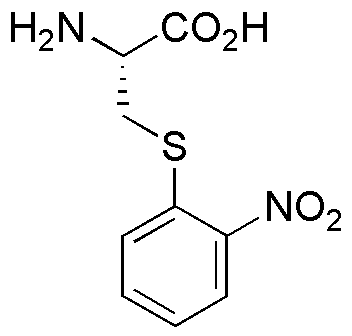S-2-Nitrophenyl-L-cysteine is widely utilized in research focused on:
- Biochemical Research: This compound serves as a valuable tool in studying protein interactions and enzyme activity, particularly in the context of redox reactions.
- Drug Development: It is used in the synthesis of novel pharmaceutical compounds, providing a framework for developing drugs that target specific biological pathways.
- Analytical Chemistry: The compound acts as a reagent in various analytical techniques, helping to detect and quantify thiol-containing compounds in biological samples.
- Antioxidant Studies: Researchers utilize it to investigate the antioxidant properties of different compounds, contributing to the understanding of oxidative stress in cells.
- Bioconjugation Applications: It is employed in bioconjugation processes, allowing for the attachment of biomolecules to surfaces or other molecules, which is crucial in developing biosensors and targeted drug delivery systems.
General Information
Properties
Safety and Regulations
Applications
S-2-Nitrophenyl-L-cysteine is widely utilized in research focused on:
- Biochemical Research: This compound serves as a valuable tool in studying protein interactions and enzyme activity, particularly in the context of redox reactions.
- Drug Development: It is used in the synthesis of novel pharmaceutical compounds, providing a framework for developing drugs that target specific biological pathways.
- Analytical Chemistry: The compound acts as a reagent in various analytical techniques, helping to detect and quantify thiol-containing compounds in biological samples.
- Antioxidant Studies: Researchers utilize it to investigate the antioxidant properties of different compounds, contributing to the understanding of oxidative stress in cells.
- Bioconjugation Applications: It is employed in bioconjugation processes, allowing for the attachment of biomolecules to surfaces or other molecules, which is crucial in developing biosensors and targeted drug delivery systems.
Documents
Safety Data Sheets (SDS)
The SDS provides comprehensive safety information on handling, storage, and disposal of the product.
Product Specification (PS)
The PS provides a comprehensive breakdown of the product’s properties, including chemical composition, physical state, purity, and storage requirements. It also details acceptable quality ranges and the product's intended applications.
Certificates of Analysis (COA)
Search for Certificates of Analysis (COA) by entering the products Lot Number. Lot and Batch Numbers can be found on a product’s label following the words ‘Lot’ or ‘Batch’.
Número de catálogo
Número de lote/lote
Certificates Of Origin (COO)
This COO confirms the country where the product was manufactured, and also details the materials and components used in it and whether it is derived from natural, synthetic, or other specific sources. This certificate may be required for customs, trade, and regulatory compliance.
Número de catálogo
Número de lote/lote
Safety Data Sheets (SDS)
The SDS provides comprehensive safety information on handling, storage, and disposal of the product.
DownloadProduct Specification (PS)
The PS provides a comprehensive breakdown of the product’s properties, including chemical composition, physical state, purity, and storage requirements. It also details acceptable quality ranges and the product's intended applications.
DownloadCertificates of Analysis (COA)
Search for Certificates of Analysis (COA) by entering the products Lot Number. Lot and Batch Numbers can be found on a product’s label following the words ‘Lot’ or ‘Batch’.
Número de catálogo
Número de lote/lote
Certificates Of Origin (COO)
This COO confirms the country where the product was manufactured, and also details the materials and components used in it and whether it is derived from natural, synthetic, or other specific sources. This certificate may be required for customs, trade, and regulatory compliance.


